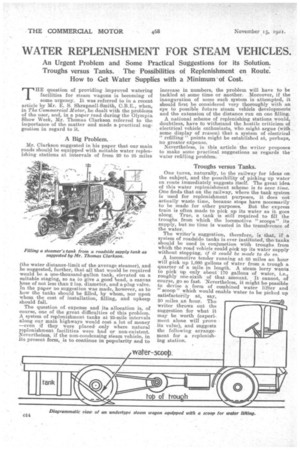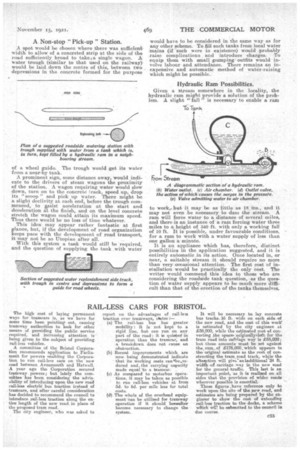WATER REPLENISHMENT FOR STEAM VEHICLES.
Page 14

Page 15

If you've noticed an error in this article please click here to report it so we can fix it.
An Urgent Problem and Some Practical Suggestions for its Solution: Troughs versus Tanks. The Possibilities of Replenishment en Route. How to Get Water Supplies with a Minimum of Cost.
THE question of providing improved watering facilities for steam wagons is becoming of some urgency. It was referred to in a recent article by Mr. E. S. Shrapnell-Smith, 0.B.E., when, in The Commercial Motor, he dealt with the problems of the user, and, in a paper read during the Olympia Show Week, Mr. Thomas Clarkson referred to the importance of the matter and made a practical suggestion in regard to it.
A Big Problem.
Mr. Clarkson suggested in his paper that our main roads should be equipped with suitable water replenishing stations at intervals of from 20 to 25 miles (the water distance-limit of the average steamer), and he suggested, further, that all that would be required would be a one-thousand-gallon tank, elevated on a suitable staging, so as to give a good head, a canvas hose of not less than 2 ins, diameter, and a plug valve. In the paper no suggestion was made, however, as to how the tanks should be filled, by whom, nor upon whom the cost of installation, filling, and upkeep should fall.
The question of expense and its allocation is, of course, one of the great difficulties of this problem. A system of replenishment tanks at 25-mile intervals along our main highways would cost a lot of money —even if they were placed only where natural replenishment facilities were bad or non-existent. Nevertheless, if the non-condensing steam vehicle, in its present form, is to continue in popularity and to increase in numbers, the problem will have to be tackled at some time or another. Moreover, if the inauguration of some such system is attempted, it should first be considered very thoroughly with an eye to possible future steatri vehicle developments and the extension of the distance run on one filling.
A national scheme of replenishing stations would, doubtless, have to withstand the hostile criticism of electrical vehicle enthusiasts, who might argue (with some display of reason) that a system of electrical " refilling " points might be established at, perhaps, no greater expense. Nevertheless, in this article the writer proposes to make some practical suggestions as regards the water refilling problem.
Troughs versus Tanks.
One turns, naturally, to the railway for ideas on the subject, and the possibility of picking up water en route immediately suggests itself. The great idea. of this water replenishment scheme is to save time. One finds that on the railway, where the tank system is used for replenishment purposes, it does not actually waste time, because stops have necessarily to be made for other purposes. But the express train is often made to pick up its water as it goes along. True, a tank is still required to fill the troughs from which the locomotive "scoops" its supply, but no time is wasted in the transference of the water.
The writer's suggestion, therefore' is that, if a system of roadside tanks is ever instituted, the tanks should be used in conjunction with troughs from which the road vehicle could pick up its water supply without stopping, if it could be made to do so.
A locomotive tender running at 60 miles an hour will pick up 1,000 gallons of water from a trough a quarter of a mile in length. A steam lorry wants to pick up only about 170 gallons of water, i.e., roughly one-sixth of that amount. It cannot, of course, go so fast. Nevertheless it might be possible to devise a form, of combined water lifter and " scoop "which would enable water to be picked up satisfactorily at, say, 20 miles an hour. The writer throws out the suggestion for what it may be worth (experiment alone will prove its value), and suggests the following arrangement for a replenishing station.
A Non-stop " Pick-up " Station.
A spot would be chosen where there was sufficient width to allow of a concreted strip at the side of the road sufficiently broad to take a single wagon. A water trough (similar to that used on the railway). would be laid down the centre of this, between two depressions in the concrete formed for the purpose
of a wheel guide. The trough would get its water from a near-by tank.
A prominent sign, some distance away, would indicate to the drivers of steam wagons the proximity of the station. A wagon requiring water would slow down, turn on to the concrete i,rack, speed up, drop its " scoop " and pick up water. There might be a slight declivity at each end, before the trough commenced, to kssist acceleration at the start and deceleration it the finish, and on the level concrete stretch the wagon could attain its maximum speed. Thus there would be no loss of time whatever.
This idea may appear rather fantastic at first glance, hut, if the development of road organization keeps pace with the development of road transport, it may not be so Utopian after all. With this system a tank would still be required, and the question of supplying the tank with water
would have to be considered in the same way as for any other scheme. To fill such tanks from local water mains (if such were in existence) would •probably raise complications. and introduce charges.. -To equip them with small pumping: outfits would involve labour and attendance. There remains an inexpensive and automatic method of water-raising which might be possible.
Hydraulic Ram Possibilities.
Given a stream somewhere in the locality, the hydraulic ram might provide a solution of the prob
lem. A slight " . is necessary to enable a ram
to work,but it may be as little as IS_ ins., and it may not even be necessary to darn the stream. A ram will force water to a distance of several miles, and there is an instance of a ram forcing water three miles to a height of 340 ft. with only a working fall of 10 ft. It is possible, under favourable conditions, for a ram to work with a water supply of less than one gallon a minute. .
It is an appliance which has, therefore, distinct possibilities in the application suggested, and it is entirely automatic in its action. Once located in, or near, a suitable stream it should require no more than very occasional attention. The first cast -of installation would be practically the only cost. The writer would commend this idea to those who are considering the roadside tank question, •as the question of water supply appears to be much more difficult than that of the erection of the tanks themselves.


































